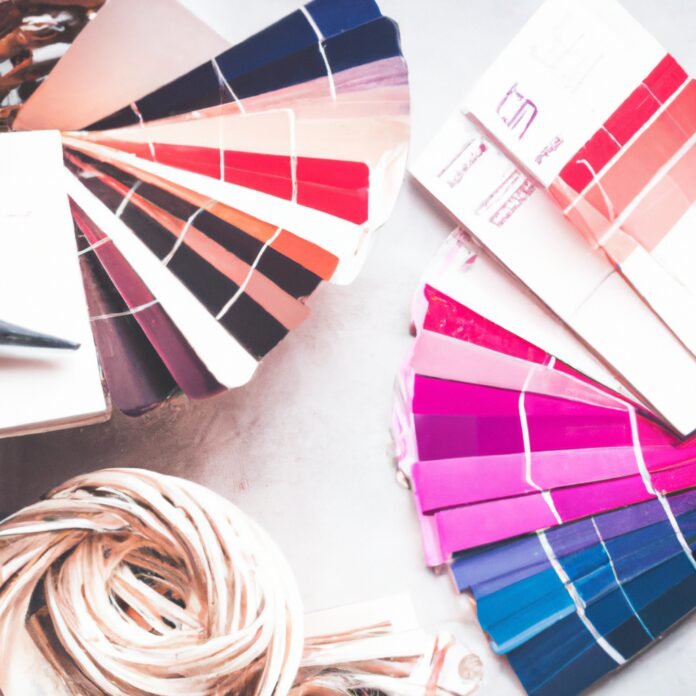Do you have trouble matching colors? Do you want to create a stylish color palette for your wardrobe or home decor but don’t know how? Worry no more! In this article, you’ll learn the secrets of color coordination and how to effortlessly create modern and attractive color combinations. So, read on to discover the essential tips for mastering color coordination and creating an eye-catching and chic appearance.
1. Unlock the Power of Color Coordination
Are you looking to enhance your style with a sophisticated touch? , and you can be sure that your look will be on point. As a timeless and powerful tool for pulling together an outfit, color coordination requires attention to detail in order to ensure the overall aesthetic works harmoniously.
The key to stylish, flattering color coordination lies in understanding the relationship of colors as they are displayed in the color wheel. Complementary colors, which sit opposite one another on the wheel, will create strong, bold contrasts that will draw attention to the featured element.
Adjacent Colors:Keeping colors to their nearest neighbors on the wheel allows for a soft, more subtle result. This form of coordination allows for the possibility of tonal variety, as darker and lighter shades of a chosen color can be incorporated. Choose one color to anchor the look and accent with several shades of it to keep the palette consistent.
Triadic Colors: Selecting three colors that are evenly spaced out on the wheel can offer the ultimate balance. For instance, sporting a blue top, orange trousers and teal shoes. This combination combines colors that sit harmoniously together to create a refreshing look.
The Power of Accent Colors: Don’t be afraid to incorporate a variety of colors to accentuate the main colors in the look. Opt for colors that can bridge both hues or emphasize them by using the same shade of each at different points. Or use patterns to bring both the original colors together, such as stripes, florals or polka dots.
2. The Psychology of Color Combination
When considering , we must dive into the art behind what makes certain aesthetically pleasing visuals stand out in our minds. Different hues vibrate differently with our aesthetic, and when used in tandem can create a lasting impression. From corporate marketing schemes to the tiniest home decor choices, the colors you pick can influence the very atmosphere of a place and the feelings you want to evoke.
Warm Colors
Warm colors typically encompass reds, oranges, and yellow. Vibrantly employed together, these colors can create a sense of sensuality, comfort, and energy. These color schemes are associated with feelings of heat, passion, and warmth, which is why we often pick these hues when we want to convey passion and energy. Used within a marketing campaign, these warmth-filled colors will draw people’s attention and create an inviting atmosphere for customers. Think of the charming color scheme of a cozy Italian restaurant.
Cool Colors
Cool colors like blues, purples, and greens provoke a sense of serenity and peacefulness.Often employed in places of healing, relaxation, and peace such as spas, meditation facilities, and yoga studios, these colors evoke a calming and tranquil atmosphere. Used within a professional setting, these colors create an air of confidence and authority, which is why such corporate giants such as Microsoft and IBM integrate it heavily into their branding.
Neutral Colors
Different shades of gray create feelings of sophistication, neutrality, and modernity. When used in tandem with the right colors, it can brighten a room and give it a more textured effect. These colors are invaluable within the corporate world due to how versatile they can be, and for the associations with intellect and calmness they project.
Strong Contrasts
When pursuing something different and eye-catching, strong contrasts between colors can make a world of difference. These combinations can create a shocking visual force, encouraging people to take second glances, as well letting us stand out in a busy sea of graphics. Contrasts between warm and cool colors, light and dark colors, and neutral and vibrantly- saturated colors compel us to take notice and create an impression in our minds.
3. Color Rules to Live By for Stylish Style
As everyone knows, color is one of the most important aspects of making a fashion statement, and it even contributes to how people perceive us. If you’re aiming for a stylish look, there are some specific things to bear in mind when selecting your outfit colors. Follow these top 3 color rules and you’ll be in prime stylishness territory.
1. Balance Brights with Neutrals If you want to make a color stand out, the easiest way to do it is by balancing it with neutral hues, like white, gray, and navy blue. This will allow your bright color to steal the show, without making the look over-the-top. Try pairing a bright-orange t-shirt with jeans and a gray coat and watch how it turns heads.
2. Stick to Monochromatic Monochromatic styling is when you select clothing items from the same color family. If your goal is a sleek look, this is the way you should go. The key to making it work is to balance different shades and textures that complements each other. Think a navy-blue cashmere sweater with dark jeans and a lighter blue coat.
3. Use Color Blocks to Make an Impact Color blocking is a technique where you wear distinctly different hues side by side. For a very stylish look, try to color-block harmonious colors that don’t compete with each other, rather than random bold colors. A great example is a hot-pink top with a yellow skirt.
4. Play with Jewel Tones Jewel tones are shades that often appear on gems, like sapphire, emerald, and ruby. For an eye-catching look, experiment with mixing and matching different jewel tones. An example of this is wearing a deep blue dress and teaming it up with a turquoise belt and a few garnet accessories.
5. Learn the Power of Accents Accenting your outfit is a great way to emphasize a certain color. To make a look more stylish, pick a single color to use as an accent. For instance, if your outfit mainly consists grays and neutrals, why not add a bright red belt to add a striking touch? The result will be nothing short of stylish perfection.
4. An Inspiring Guide to Color Coordination in Your Home
Color can bring a whole new life to any room in your home. Taking the time to thoughtfully select paint colors and home accents can turn a boring, bland house into a fabulous, functional living space. Whether you’re making minor updates to a specific room or giving your entire house a complete makeover, here’s .
Step One: Choose a Palette
Before you start shopping for paints and tiles, decide on a color palette for your home. If you’re having trouble deciding, take inspiration from items you already own—such as artwork, furniture, and flooring. This can help create a unified look in your home, and will make it easier to find compatible shades. If possible, sample the shades to get a better idea of how they’ll look when juxtaposed with each other.
Step Two: Consider Color Theory
We can’t all be interior decorators, so it pays to know a few basic tips. First, choose a maximum of three colors for the main palette of your home. Vibrant colors look best when accented with a neutral hue. To add depth, use similar hues of the same color. Here are some color combinations to consider:
- Grey and white tones
- Cool blues and light greens
- Mustard yellow and earthy brown
- Soothing peaches and taupes
- Pale pink, ivories, and charcoal
Step Three: Add Accents
Once you’ve nailed down your foundational colors, start thinking about how you can add interest with accessories. Curtains, area rugs, and throw pillows are some of the most effective ways to spice up a room and add dimension. Try choosing a bright color or two to bring life into your home without overwhelming it. And, don’t be afraid to add metallics—like copper, brass, and silver—to round out the look.
Step Four: Get Creative
Finally, experiment with shades, fabrics, and textures to bring your vision to life. Pillowcases and duvets are great ways to add color where necessary. To complete the look, pick up a few artworks to make the space your own. Don’t be afraid to establish a certain mood or feel in your home. There’s no need to be symmetrical—just select shades that you love and make sure to keep the harmony.
Find your personal style by using color coordination in creative ways! Taking these color combination tips into account can help you cultivate an aesthetically pleasing, stylish, and eye-catching look. With some practice and experimentation, you’ll soon be a pro in the art of color coordination!




